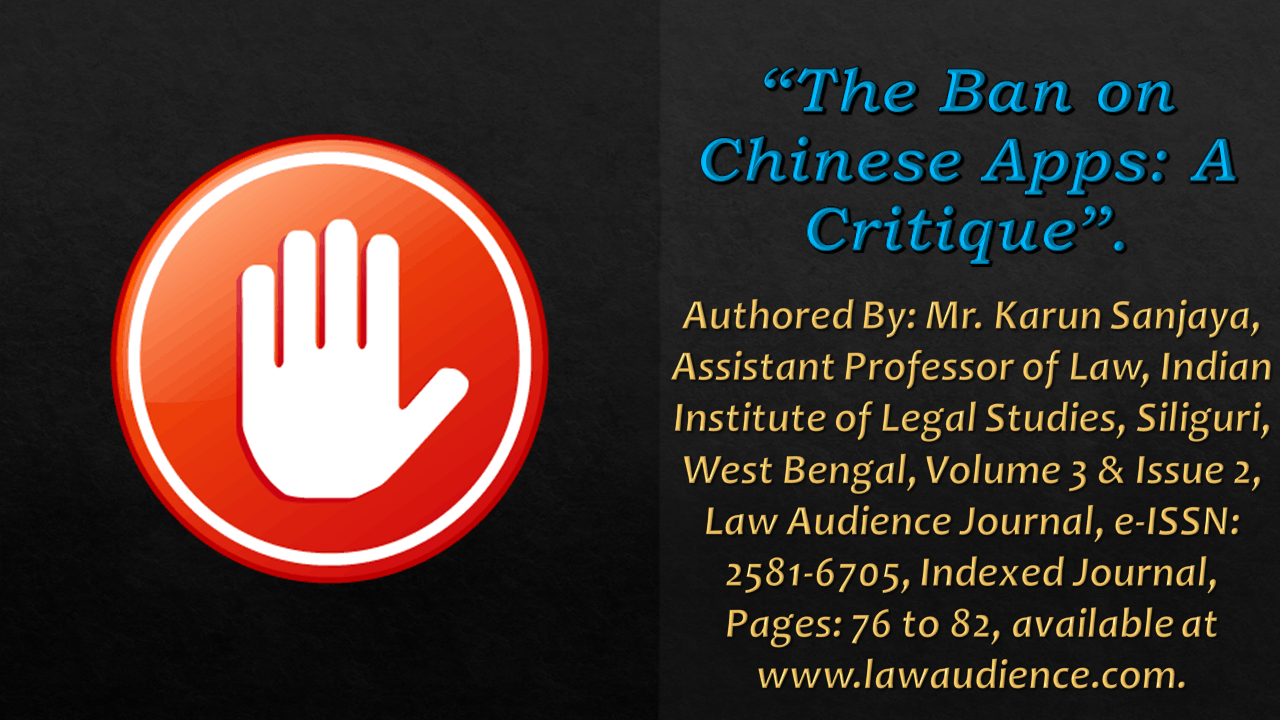Click here to download the full paper (PDF)
Authored By: Mr. Karun Sanjaya, Assistant Professor of Law, Indian Institute of Legal Studies, Siliguri, West Bengal,
Click here for Copyright Policy.
ABSTRACT:
“In the era of an information revolution, the role played by mobile and computer applications in revenue generation is tremendous. India has set an example of hitting back on the Chinese with an unconventional method, popularly referred to as “The Digital Strike”. In retaliation to the Chinese aggression on the Indian borders, India announced and implemented an outright ban on fifty-nine Chinese apps initially and later went on to ban many more. The paper analyzes the provisions of the “Information Technology Act, 2000” and that of the “Information Technology (Procedure and Safeguards for Blocking of Access of Information by Public) Rules, 2009”, which were used to impose the ban in an attempt to study the legality and aftermath of the ban.
The paper is divided into five parts. Part I, titled “Introduction”, provides background information on the events that led to the ban. Part II, titled “Legality of the Ban”, analyzes the relevant provisions of the Information Technology Act, 2000 and that of the Information Technology (Procedure and Safeguards for Blocking of Access of Information by Public) Rules, 2009 to find out whether the imposed ban is within the powers of the Central Government. Part III, titled “Aftermath of the Ban”, looks into the consequences of the ban. Part IV, titled “Recourse Available to China”, explores the recourse available to China against the ban. Part V, titled “Conclusion”, concludes the paper with a brief comment on the correctness of the ban”.
Keywords: Chinese Apps, Ban, Legality, Information Technology Act, Aftermath.
I. INTRODUCTION:
Though both the countries have had their share of problems in the past, India and China were on good terms, socially and politically. Recently, the Indo-China relations got strained due to various reasons, including, inter alia, imposition of strict restrictions on Chinese Foreign Direct Investments[1]. However, the relationship worsened due to the confrontation at the Indo-China border at Galwan Valley, which resulted in the death of 20 Indian army personnel[2]. The same can be identified as the triggering event that led to the ban on Chinese applications. Soon after the clash at the Indo-China border made headlines in major media, the Government of India announced the ban on fifty-nine Chinese mobile applications and called it a “Digital Strike” on China[3]. India cited privacy concerns and national security as a reason to impose the ban[4]. It was further claimed that the banned apps gave no regard to the user’s privacy and shared the data collected with Chinese agencies,[5] thereby disclosing private and sensitive information which the user divulges to use the app. Later, the government announced a ban on additional forty-seven apps which were alleged to be the cloned versions of those banned earlier[6], and went on to place another 250 apps under the lens of scrutiny[7]. By September 2020, India had banned a total of 224 Chinese apps, including the famous – PubG and TikTok, citing that they pose a threat to the sovereignty, integrity, defence, and security of India[8].
II. LEGALITY OF THE BAN:
The Government of India invoked its powers under “The Information Technology Act, 2000”[9] (hereinafter referred to as the “IT Act, 2000), and “The Information Technology (Procedure and Safeguards for Blocking of Access of Information by Public) Rules, 2009”[10] (hereinafter referred to as the “IT Rules, 2009”). The IT Rules, 2009 were made by the central government by exercising its powers under Section 87 (2) (z) of the IT Act, 2000, which permits the Central Government to make rules with respect to the procedures and safeguards for blocking of access by the public.
The IT Act, 2000 empowers the Central Government to direct any government agency or intermediary to block access by the public of any information in any computer resource if it is satisfied that the same is necessary in the interest of “sovereignty and integrity of India, defence of India, security of the State, friendly relations with foreign States or public order or for preventing incitement to the commission of any cognizable offence relating to above.”[11] The Act also penalizes intermediaries, with imprisonment up to seven years and a fine, if they do not comply with such a direction of the Central government[12]. The IT Rules, 2009, provides for the procedure to be followed when emergency blocking of access by the public is sought[13].
When the Central Government invokes its power under Section 69A, the designated officer (designated in accordance with Rule 3 of the IT Rules, 2009) has to submit a request before the Secretary, Department of Information Technology to block the access[14]. The Secretary, on being satisfied that it is necessary or expedient to block such access, may, after recording reasons in writing, issue such directions to the intermediary without affording an opportunity to be heard to such intermediary[15]. However, the same is considered an interim measure[16], and a final order is passed only after considering the recommendations of the committee[17], which then examines the said request. Therefore, the law clearly equips the Central Government with the power to impose a ban on any apps if it is satisfied that the usage of such app is prejudicial to the sovereignty and integrity of India, security of the State, etc. The ban on Chinese apps was also sought by invoking these powers and after being satisfied that the app poses a threat to the security of the nation. India claimed that the banned apps gave no regard to the user’s privacy and shared the data collected with Chinese agencies,[18] thereby disclosing private and sensitive information which the user divulges to use the app.
Moreover, if the user of such an app is an army personnel or their family member happens to be one, the apps pose a threat to the defence and security of our nation. Besides, the lack of data protection law in India and the absence of a line demarcating legal and illegal data mining poses further challenges to tackle such a scenario. Indian data protection law is still in its making and has a long way to go before it can be made into an act of law. The more the delay, the more is the uncertainty involved. It is amidst such uncertainties; the Government of India has to take decisions like the digital strike.
III. AFTERMATH OF THE BAN:
The spokesperson of the Chinese Embassy in India, Mr. Ji Rong, termed the ban as discriminatory and as an abuse of the national security exception[19]. It is interesting to note that top lawyers in India refused to take up the case challenging the ban in courts of law[20]. Though refusing legal representation may not be professionally and ethically sound, the same can be justified in the larger interest of the nation, particularly when the charges levelled against are those concerning national security. However, in a nation where even a person alleged of terrorism gets adequate legal representation, such a refusal might seem unjust. The ban not only resulted in a major loss of revenue that amounted up to billions for the Chinese corporates[21] but also facilitated the entry of many Indian apps like Chingari, Gaana Hotshots, MX Taka Tak, etc. However, Instagram’s Instagram Reels, a similar initiative to that of TikTok, seems to have conquered the TikTok market[22]. Nevertheless, the Indian version of PubG, Battleground Mobile India (BGMI), was able to conquer the PubG market[23].
Therefore, it can be said that the ban on Chinese apps has given an opportunity for the Indian IT sector to conquer the e-gaming market. Besides, it has also sent a strong message that India will not tolerate the misuse of data collected from its citizens. However, India’s economic dependence on Chinese products in many crucial sectors should be given some thought before digital strikes like this are announced. Though China cannot afford to lose the Indian market, India is equally dependent on Chinese products. The realization that both countries are dependent on each other when it comes to trade might be the reason why the tensions have cooled down a bit.
IV. RECOURSE AVAILABLE TO CHINA:
The IT Rules, 2009 does not provide for an appeal mechanism, therefore, the chances of getting the ban order overturned in a court of law are slim. However, that does not mean there is no recourse available. China can take recourse under International Investment Law as India and China have entered into a Bilateral Investment Treaty (BIT) in 2007[24]. The terms of the treaty require India to protect investments made by China in India. Though the treaty got terminated in 2018[25], the sunset clause of the treaty requires India to protect investments made by China in India before the termination of the treaty for the next fifteen years[26].
The banned apps constitute an investment in the sense that the source codes and user interface would come within the purview of Intellectual Property Rights. Therefore, India is under an obligation under the BIT to protect such investments. However, India has carefully resorted to national security exception, which is not only a ground under the IT Act, 2000 but also under the BIT[27]. The BIT provides two situations where the obligations under the treaty may be overlooked: a) for the protection of essential security interests and b) in situations of extreme emergency[28].
The Central Government, while invoking its powers under Section 69A, has cited that the apps pose a threat to the sovereignty, integrity, defence and security of the State, thereby barring China from seeking recourse under the BIT. The grey area, however, lies in the question of whether India would be able to effectively prove that there existed “essential security interests” or “extreme emergency” in order to impose the ban. If China seeks recourse under the BIT and India fails to prove that the ban was imposed in light of the aforementioned grounds, India would have to pay a huge sum as compensation to China. Such a penalty at a time when the Indian economy is struggling due to the pandemic can prove to be disastrous.
V. CONCLUSION:
Whether due to the ban or not, the Chinese military aggression at the Indo-China borders seems to have died out gradually. However, whether such blocking orders are a viable option to resort in such circumstances is a question that needs to be mooted. On a personal note, the author prefers such measures over bloodshed and wars. China may not be able to get a favourable verdict if it approaches WTO Panel as WTO recognizes a surfeit of security exceptions. Therefore, the only feasible option for China is to take shelter under the International Investment Law.
Though national security is of prime concern and the ban of those apps that pose a threat to national security is justified, the consequences of the ban can be catastrophic if China takes recourse under international investment law and becomes successful. Though China’s chances of succeeding in arbitration are slim[29], the possibility cannot be overruled.
Footnotes & References:
[1] S.R. Padakandla and N. Sahoo, India’s China FDI Gamble, THE DIPLOMAT, (May 23, 2021, 01:46 AM). https://thediplomat.com/2020/05/indias-china-fdi-gamble/.
[2] Manu Pubby, Over 20 soldiers, including Commanding Officer killed at Galwan border clash with China, THE ECONOMIC TIMES, (May 23, 2021, 01:46 AM) https://economictimes.indiatimes.com/news/defence/over-20-soldiers-including-commanding-officer-killed-at-galwan-border-clash-with-china/articleshow/76410908.cms.
[3] Press Information Bureau, Government Bans 59 mobile apps which are prejudicial to sovereignty and integrity of India, defence of India, security of state and public order. PIB, (May 23, 2021, 01:54 PM), https://pib.gov.in/PressReleasePage.aspx?PRID=1635206.
[4] Ibid.
[5] Ibid.
[6] The Economic Times, India bans 47 more Chinese apps; Report, ET TELECOM, (May 23, 2021, 02:24 PM), https://telecom.economictimes.indiatimes.com/news/india-bans-47-more-chinese-apps-report/77192904.
[7] The Financial Express, India bans 47 more Chinese mobile apps, 250+ apps reportedly under scanner over privacy concerns, FE ONLINE, (May 23, 2021, 02:27 PM), https://www.financialexpress.com/industry/technology/india-bans-47-more-chinese-mobile-apps-250-apps-reportedly-under-scanner-over-privacy-concerns/2036181/.
[8] Surabhi Sabat, Full List Of 224 Chinese Apps Banned In India Till Date; Including PUBG, TikTok And Shein, REPUBLICWORLD, (May 25, 2021, 01:06 PM) https://www.republicworld.com/technology-news/apps/how-many-chinese-apps-banned-in-india-till-now-see-the-full-list.html
[9] The Information Technology Act, 2000 (Act No. 21 of 2000), s. 69A.
[10] The Information Technology (Procedure and Safeguards for Blocking of Access of Information by Public) Rules, 2009, R.9.
[11] The Information Technology Act, 2000 (Act No. 21 of 2000), s. 69A (1).
[12] The Information Technology Act, 2000 (Act No. 21 of 2000), s. 69A (3).
[13] The Information Technology (Procedure and Safeguards for Blocking of Access of Information by Public) Rules, 2009, R.9.
[14] Id at R. 9 (1).
[15] Id at R. 9 (2).
[16] Ibid.
[17] Committee means a committee constituted under Rule 7 of the IT Rules, 2009 and which examines the request for blocking access of information by public.
[18] Ibid.
[19] Embassy of the People’s Republic of China in the Republic of India, Response to media query by Spokesperson of Chinese Embassy in India Counselor Ji Rong on media reports that India will continue to ban Mobile Apps with Chinese Background, IN.CHINA-EMBASSY, (May 24, 2021, 10:17 PM), http://in.china-embassy.org/eng/embassy_news/t1848846.htm.
[20] Alok Prasanna Kumar, Top lawyers’ refusal to defend TikTok undermines India’s claims of being rule of law country, FIRSTPOST, (May 24, 2021, 10:53 PM), https://www.firstpost.com/india/abhishek-singhvi-and-mukul-rohatgis-refusal-to-defend-tiktok-undermines-indias-claims-of-being-rule-of-law-country-8551061.html.
[21]Press Trust of India, TikTok Expects Over $6 Billion Loss After India’s Ban On App: Report, NDTV, (May 25, 2021, 02:40 PM), https://www.ndtv.com/india-news/tiktok-expects-over-6-billion-loss-after-indias-ban-on-app-report-2256800.
[22] IANS, Instagram Reels emerges top choice in Tik Tok’s absence in India, NATIONAL HERALD, (May 25, 2021, 02:47 PM), https://www.nationalheraldindia.com/national/instagram-reels-emerges-top-choice-in-tik-toks-absence-in-india.
[23] Maryam Farooqui, Entry of PUBG’s Indian avatar Battleground Mobile India to drive-in app revenue in esports, MONEY CONTROL, (Aug 22, 2021 12:37 AM), https://www.moneycontrol.com/news/trends/entertainment/entry-of-pubgs-indian-avatar-battlegrounds-mobile-india-to-drive-in-app-revenue-in-esports-7141151.html.
[24] Agreement Between The Government of The Republic of India and The Government of The People’s Republic of China For The Promotion And Protection of Investments, 2007.
[25] Department of Economic Affairs, Bilateral Investment Treaties (BITs)/Agreements, DEA, https://dea.gov.in/bipa?page=5.
[26] Agreement Between The Government of The Republic of India and The Government of The People’s Republic Of China For The Promotion and Protection of Investments, 2007, art 16 (2).
[27] Id at art. 14.
[28] Ibid.
[29] See Agreement Between The Government of The Republic of India and The Government of The People’s Republic Of China For The Promotion and Protection of Investments, 2007, art 14.
Cite this article as:
Mr. Karun Sanjaya, The Ban on Chinese Apps: A Critique, Vol.3 & Issue 2, Law Audience Journal (e-ISSN: 2581-6705), Pages 76 to 82 (19th September 2021), available at https://www.lawaudience.com/the-ban-on-chinese-apps-a-critique/.



